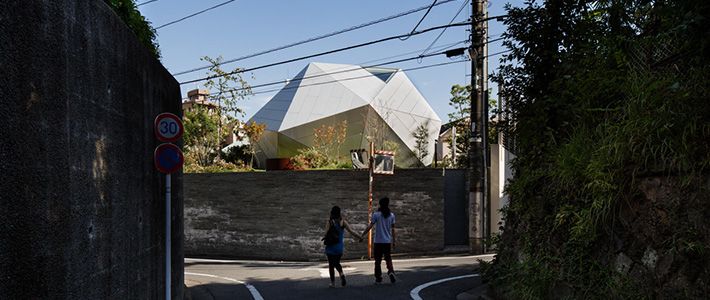
Unique Tokyo Houses Add Individual Touch to City Landscape (Photos)
Culture- English
- 日本語
- 简体字
- 繁體字
- Français
- Español
- العربية
- Русский
I first visited Tokyo in the summer of 2005. Every year the cicadas, heat, and humidity remind me of that month of pacing the city and its suburbs in complete freedom.
Tokyo confounds foreign visitors with its steady stream of sensory input. Scenes of contrasts abound, from the narrow yokochō alleys packed with small drinking establishments that crowd around the feet of Shinjuku’s towering office buildings to the cacophonous pachinko parlors abutting quiet residential areas. I was living in Paris at the time and could not help but draw comparisons. Paris seemed uniform and conservative while Tokyo was full of surprises and discoveries. Seduced by the freshness of my experiences, I resolved to live there one day. Four years later, I left Paris and my job as an engineer to devote myself to photography in Tokyo.
Residential Streets of Tokyo
Soon after arriving I hit on the idea of introducing Tokyo’s residential neighborhoods, places that I love strolling through and that are too little known in the West. In France, Tokyo is often represented only by Shibuya’s bustling scramble crossing, but serene enclaves of private homes extend across the city. At the same time, I wanted to highlight contemporary architecture, which is not commonly applied at the residential level in France but is quite dynamic in Japan. By putting these two themes together and photographing contemporary homes in Tokyo, my project Tokyo no ie (Tokyo Houses) was born.
 BB; Yō Yamagata Architects. (Photograph taken on February 15, 2011)
BB; Yō Yamagata Architects. (Photograph taken on February 15, 2011)
Tracking Down Houses
First I had to decide which houses to shoot. I chose to focus on metropolitan Tokyo and only photograph homes constructed after 2000.
To find subjects I searched Japanese architecture magazines cover to cover and gleaned what I could from architecture-related websites. The houses had to be surprising either in their form or in their relationship to their surrounding environs. Most homes that I shot would not have been allowed in Paris due to the city’s strict regulations covering exteriors. Some did not even have a window looking out onto the street, something unthinkable in the French capital. With other houses, the contrast with the surrounding buildings or relation to a lively setting—such as a bus stop or school—caught my attention.
 Houses against a backdrop of skyscrapers in Shinjuku. (Photograph taken on January 10, 2013)
Houses against a backdrop of skyscrapers in Shinjuku. (Photograph taken on January 10, 2013)
Finding addresses of homes I wanted to photograph was no easy task. At the start of the project the architects I contacted were wary of me and few even deigned to respond to my queries for fear of infringing on the privacy of home owners. As a result, I had to spend long hours cross-checking information from ground plans in magazines against Google Maps and searching the Internet in Japanese for clues. This was certainly the hardest part of the project.
Streets as Theater
I have a background in documentary photography and admire great works of reportage and humanism, so I am not interested in taking pictures of buildings alone. I chose a horizontal format to integrate as much of the surrounding urban environment as possible. To distance myself from the typical commercial style of architectural photography, I sought to capture snapshots of the city’s residential neighborhoods that blended street scenes and architecture.
 House in Nakameguro; Yoritaka Hayashi Architects. (Photograph taken on March 21, 2013)
House in Nakameguro; Yoritaka Hayashi Architects. (Photograph taken on March 21, 2013)
The houses are thus presented as is, without makeup or glitter and showing the effects of the passage of time. They appear alongside such quotidian elements as passers by, road construction workers, local residents, hanging laundry, curtains, waste containers, and parked cars. Like design, architecture is for me a form of art intended for human usage. For this reason, people have an important role in nearly all of the photographs in this series.
(The photographs in this article appear in the collection Tokyo no ie (Tokyo Houses) published in France in 2014 by Le Lézard Noir and in a different format in Japan in 2017 by Seigensha.)
(Originally published in French on August 14, 2017. Photographs and text by Jérémie Souteyrat. Banner photo: Hironaka House in Tokyo; Ken Yokogawa Architect & Associates. Photograph taken on August 6, 2010.)

A Life With Large Opening; ON Design Partners. (Photograph taken on May 30, 2013)

House NA; Sou Fujimoto Architects. (Photograph taken on July 23, 2012)

Room Room; Takeshi Hosaka Architects. (Photograph taken on October 11, 2013)

YY House; AH Architects. (Photograph taken on September 15, 2010)

WEP Shimokitazawa; Niizeki Studio. (Photograph taken on September 17, 2013)

White Base; Akira Yoneda/Architecton. (Photograph taken on November 12, 2010 with assistance of Bruno Bellec)

Moriyama House; Office of Ryue Nishizawa. (Photograph taken on November 11, 2010)

Kitchenless House; Iizuka Atelier. (Photograph taken on March 8, 2013)

House Tokyo; ALX/Sampei Jun’ichi. (Photograph taken on September 7, 2012)

House in Inokashira; Studio Noa. (Photograph taken on July 13, 2011)

Reflection of Mineral; Atelier Tekuto. (Photograph taken on August 6, 2010)

Lucky Drops; Atelier Tekuto. (Photograph taken on September 21, 2010)

Glass Shutter House; Shigeru Ban Architects. (Photograph taken on November 19, 2010)

Sakura; Mount Fuji Architects Studio Masahiro Harada + Mao. (Photograph taken on November 10, 2010)

Kudan House; Sakane Keikaku Sekkei. (Photograph taken on October 8, 2013)